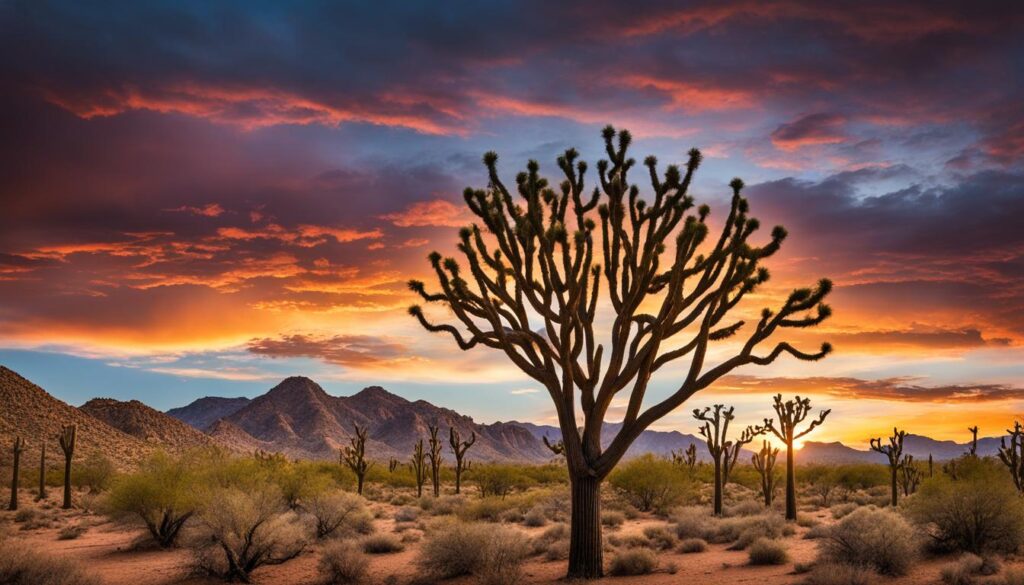Growing trees in the Southwest, from Arizona to Texas, presents unique challenges due to the region’s arid climate. To ensure successful tree growth, it is crucial to choose species that are well-suited to the Southwest’s regional climate. In this complete tree guide, I will provide you with essential information on selecting, planting, and caring for trees in the Southwest.
Based on factual data and expert advice, this guide will help you make informed decisions when it comes to choosing resilient trees that can thrive in the Southwest’s arid conditions. Whether you are a homeowner, gardener, or landscaper, the information provided will assist you in creating a vibrant and sustainable landscape.
Key Takeaways:
- Choose tree species that are resilient and can withstand the effects of climate change in the Southwest.
- Look for trees that are drought-tolerant and disease-resistant for optimal growth in the arid conditions.
- Proper soil preparation and watering techniques are essential for successful tree planting and care in the Southwest.
- Consider the unique characteristics, such as vibrant flowers or unique foliage, of each tree species before making your selection.
- By following the recommendations and tips in this guide, you can create a lush and thriving landscape in the Southwest region.
Choosing Resilient Trees for the Southwest
As climate change continues to impact our environment, it is crucial to select resilient trees that can withstand the challenges posed by arid conditions in the Southwest. These trees have the ability to adapt and thrive in the face of changing climate patterns, making them essential for creating sustainable landscapes.
Resilient trees are characterized by their ability to tolerate drought, heat, and other stressors associated with arid conditions. They have developed mechanisms to conserve water, such as deep root systems and waxy leaves that reduce water loss through evaporation. By selecting these trees for your property, you not only contribute to the preservation of Southwest ecosystems but also ensure the longevity of your landscape.
“Resilient trees are nature’s answer to climate change. They have evolved over time to survive in harsh environments and can continue to thrive despite the challenges posed by changing weather patterns.”
When choosing resilient trees for the Southwest, it is important to consider their adaptability to the specific microclimates within the region. While some trees are better suited for the desert-like conditions of Arizona, others may thrive in the more humid areas of Texas. Consulting with local horticulturalists and arborists can provide valuable insights into the best tree species for your location.
To help you make an informed decision, we have compiled a list of the most resilient tree species for the Southwest:
| Tree Species | Adaptability | Drought Tolerance | Climate Suitability | Key Features |
|---|---|---|---|---|
| Palo Verde | High | Excellent | Arizona, New Mexico, Nevada | Yellow flowers, green bark |
| Texas Ebony | High | Excellent | South Texas | Dark green foliage, beautiful form |
| Mexican Fan Palm | Medium | Moderate | Arizona, Southern California | Iconic palm tree, fan-shaped leaves |
| Desert Willow | High | Excellent | New Mexico, Texas | Graceful flowers, drought-tolerant |
Note: This table showcases a selection of resilient tree species for the Southwest. Consult with local experts to determine the best choices for your specific location.
These resilient trees have proven their ability to thrive in the arid conditions of the Southwest. By incorporating them into your landscape, you can create a visually appealing environment that withstands the challenges of climate change.
Top Tree Recommendations for the Southwest
When it comes to selecting trees for the Southwest region, it’s essential to choose species that can withstand the arid conditions and thrive in this unique climate. After thorough research and expert consultation, I have compiled a list of the top tree recommendations for the Southwest.
These trees have been carefully chosen for their drought tolerance, disease resistance, and overall beauty. Whether you’re looking for vibrant flowers or unique foliage, there’s a tree on this list that will suit your needs. Each tree offers specific characteristics that make it well-suited to the Southwest climate.
Here are my top three recommendations for Southwest trees:
- Desert Willow (Chilopsis linearis) – This drought-tolerant tree features beautiful trumpet-shaped flowers that attract pollinators. It can thrive in the arid conditions of the Southwest and is highly resistant to diseases.
- Arizona Cypress (Cupressus arizonica) – With its stunning blue-green foliage, the Arizona Cypress is a popular choice for its ability to withstand extreme drought and heat. It provides excellent privacy and is resistant to common tree diseases.
- Texas Mountain Laurel (Sophora secundiflora) – Known for its aromatic purple flowers and glossy dark green leaves, the Texas Mountain Laurel is both drought-tolerant and disease-resistant. It thrives in the Southwest’s arid climate and adds beauty to any landscape.
These top tree recommendations not only enhance the aesthetic appeal of your landscape but also ensure their survival in the Southwest’s challenging climate. By planting these drought-tolerant and disease-resistant trees, you can enjoy their beauty and benefits for years to come.

| Tree Name | Drought Tolerance | Disease Resistance | Overall Beauty |
|---|---|---|---|
| Desert Willow | High | High | Yes |
| Arizona Cypress | Extreme | High | Yes |
| Texas Mountain Laurel | High | High | Yes |
Tips for Successful Tree Planting and Care in the Southwest
When it comes to planting and caring for trees in the Southwest, there are several key factors to consider. The arid climate and unique soil conditions present challenges that require special attention for successful tree growth. In this section, I will provide you with expert tips and advice to help you navigate the Southwest climate and ensure your trees thrive.
1. Soil Preparation
Before planting your trees, it’s important to prepare the soil properly. Southwest soils can be sandy, rocky, or clayey, which can affect drainage and nutrient availability. Here are some soil preparation tips:
- Test the soil pH to determine if any amendments are needed.
- Improve soil structure by adding organic matter, such as compost or well-rotted manure.
- Ensure proper drainage by creating raised beds or adding sand for sandy soils.
2. Tree Selection
Choosing the right tree species that are well-adapted to the Southwest climate is essential. Look for trees that are heat tolerant, drought-resistant, and disease-resistant. Native species are often a good choice as they have naturally adapted to the local conditions. Some popular tree choices for the Southwest include:
| Tree Species | Characteristics |
|---|---|
| Palo Verde | A drought-tolerant tree with vibrant yellow flowers and green bark. |
| Mesquite | Tolerates heat and drought, with feathery foliage and fragrant flowers. |
| Texas Ebony | A small to medium-sized tree with dense foliage and dark, attractive bark. |
3. Proper Watering
Watering is crucial for tree establishment in the Southwest climate. Here are some watering tips to keep in mind:
- Water deeply and infrequently to encourage deep root growth and drought tolerance.
- Avoid frequent shallow watering, as it can lead to shallow root systems and water stress.
- Use mulch around the base of trees to retain moisture and reduce evaporation.
4. Pruning and Maintenance
Regular pruning and maintenance are essential for the health and aesthetics of your trees. Follow these tips:
- Prune dead or diseased branches to maintain tree health.
- Properly shape young trees to promote a strong structure and prevent future issues.
- Monitor for pests and diseases, and take appropriate action if necessary.
By following these tree planting and care tips, you can ensure the success and longevity of your trees in the challenging Southwest climate. Remember to choose the right tree species, prepare the soil adequately, provide proper watering, and perform regular maintenance to keep your trees thriving and beautiful.

Conclusion
In conclusion, selecting and growing trees in the Southwest region, from Arizona to Texas, requires careful consideration of species that are resilient and well-suited to the arid conditions. The Southwest’s unique regional climate poses challenges to tree growth, but with the proper knowledge and guidance provided in this complete tree guide, you can create a lush landscape that thrives in this environment.
By following the top tree recommendations for the Southwest, you can ensure that you choose species that are not only beautiful but also drought-tolerant and disease-resistant. These trees have been carefully selected based on their ability to withstand the arid conditions of the region and maintain their health and beauty.
Furthermore, implementing the recommended tips for successful tree planting and care in the Southwest will give your trees the best chance for long-term growth. From proper soil preparation to watering techniques suited to the regional climate, these practices will support the health and vitality of your trees.
Ultimately, with the information provided in this tree guide, you are well-equipped to make informed decisions when it comes to selecting, planting, and caring for trees in the Southwest. By choosing the right species and providing proper care, you can create a thriving landscape that enhances the natural beauty of the region.
FAQ
What are the best tree choices for the Southwest region?
The best tree choices for the Southwest region include desert willow, Texas ebony, palo verde, and Arizona cypress, among others. These trees are well-suited to the arid conditions and have excellent drought tolerance.
How can I ensure the survival of trees in the face of climate change?
To ensure the survival of trees in the face of climate change, it is important to choose resilient species. Look for trees that have shown resistance to changing climate patterns and have proven their ability to thrive in arid conditions. Additionally, proper care and maintenance, such as regular watering and monitoring for pests and diseases, can help trees withstand the effects of climate change.
What are some recommended drought-tolerant trees for the Southwest?
Some recommended drought-tolerant trees for the Southwest include sycamore, desert willow, acacia, and mesquite. These trees have adapted to arid conditions and can survive with minimal watering once established.
How do I properly plant trees in the Southwest?
Proper tree planting in the Southwest entails preparing the soil adequately by loosening compacted soil, ensuring proper drainage, and adding organic matter. Dig a hole that is wider than the root ball but not deeper. Place the tree in the hole, backfill with soil, and water thoroughly. Mulching around the base of the tree can help retain moisture and suppress weeds.
What are some tips for caring for trees in the Southwest climate?
When caring for trees in the Southwest climate, it is important to water deeply and infrequently, as this encourages deep root growth. Avoid overwatering, as it can lead to root rot. Regularly check for pests and diseases, and prune trees to promote healthy growth. Applying mulch around the base of the tree can help conserve moisture and regulate soil temperature.

